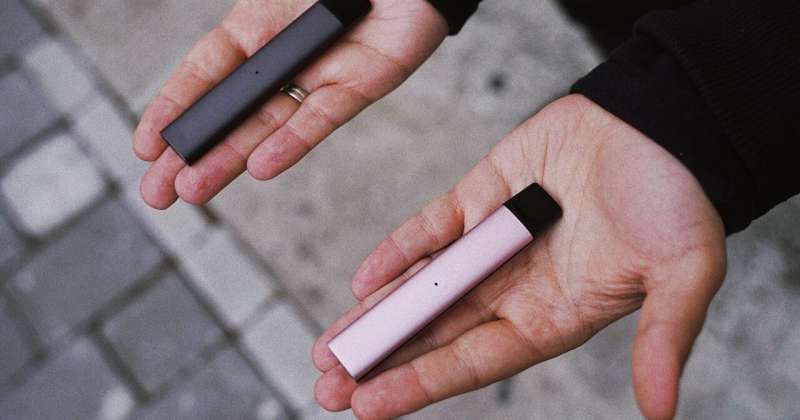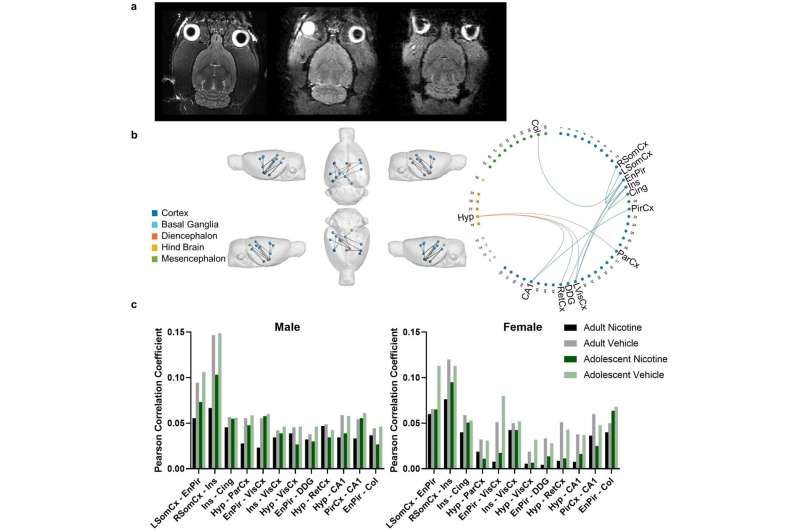This article has been reviewed according to Science X's editorial process and policies. Editors have highlighted the following attributes while ensuring the content's credibility:
fact-checked
peer-reviewed publication
trusted source
proofread
New study on vapes challenges belief that adolescents experience less severe withdrawal symptoms

Vapes or e-cigarettes were introduced as a potentially safer alternative to traditional smoking to curb tobacco use. However, the popularity of vapes has risen among an age group they weren't intended for: adolescents.
While the entire breadth of the health effects of vaping is still being unveiled, previous research has shown one in four high school students in Canada have reported vaping in the preceding 30 days, with almost 12 percent having reported exclusively using nicotine vapes.
A new study, published in the journal Neuropsychopharmacology, examined the effects of nicotine vapor exposure in rat models to understand nicotine-induced reward and withdrawal behavior, brain connectivity and how the body processes nicotine.
The study, led by Western professor Jibran Khokhar and graduate student and Vanier scholarship winner Jude Frie, has shown that factors of sex and age influence the body's response to nicotine vapor.
"By using the route of exposure and brain circuit assessment methods akin to those used in humans, the findings here can hopefully demystify the effects of nicotine vaping on the adolescent and the adult human brain, and the important role that sex plays in these effects," said Khokhar, Canada Research Chair in Translational Neuropsychopharmacology and professor at Western's Schulich School of Medicine & Dentistry.
The study has shown adult female rats were more likely to acquire a liking for longer exposures to nicotine vapor, while female adolescent rats, as well as male adult and adolescent rats, did not show the same level of preference.
Additionally, adult and adolescent male rats experienced symptoms of withdrawal and increased activity due to nicotine vapor exposure, while female rats did not exhibit these symptoms.
The study also revealed that adult females had higher nicotine levels in their bodies and brains compared to adult males and adolescent females.

"Brain connectivity in the nicotine-exposed rats was altered, indicating that vaping affects the brain differently depending on age and gender," said Khokhar. Understanding these complexities is vital not only for addressing the risks associated with vaping but also for developing effective strategies to protect vulnerable populations, especially youth, from the potential harms of e-cigarette use.
"This study also highlights the importance of being mindful of sex differences in drug disposition, which would then alter the drug effects. Far too often, the same doses are used in both sexes, but how much of the drug actually gets to the brain or blood is never tested," said Khokhar.
Open-source methods to study nicotine vapor effects
While vaping has become popular, methods to study the effects of inhaling vapor are limited. The team of researchers led by Khokhar developed an open-source apparatus to conduct research on the behavioral and physiological effects of vaping, particularly in rodents.
The apparatus, called OpenVape, is low-cost and can be customized to work with various types of vaporizers. This includes not only e-cigarettes but also other vaporizers designed for different substances, such as nicotine pods, tanks, cannabis flowers or concentrates.
"By using open-source tools like our OpenVape system, this type of study becomes accessible for researchers from various walks of life. Importantly, we hope by reducing the barriers to entry to perform this type of research, we can jumpstart additional lines of inquiry by other groups to learn more about this pressing topic with high public health relevance," said Khokhar.
More information: Jude A. Frie et al, Factors influencing JUUL e-cigarette nicotine vapour-induced reward, withdrawal, pharmacokinetics and brain connectivity in rats: sex matters, Neuropsychopharmacology (2023). DOI: 10.1038/s41386-023-01773-3


















